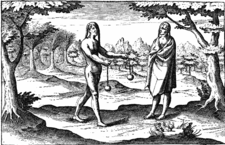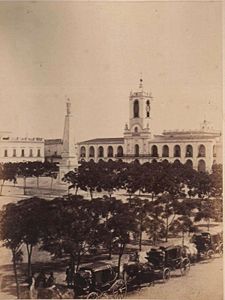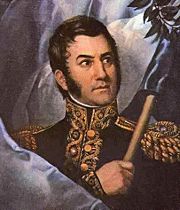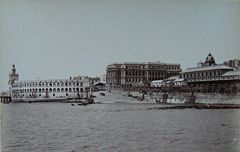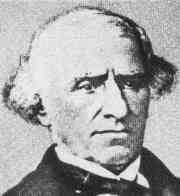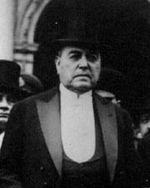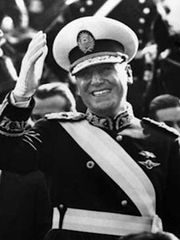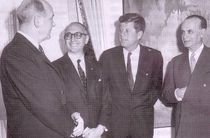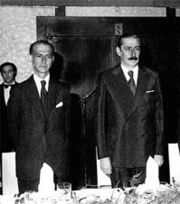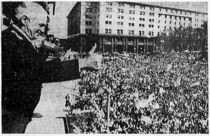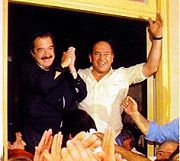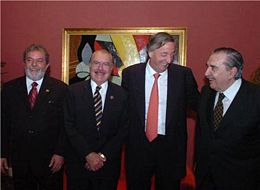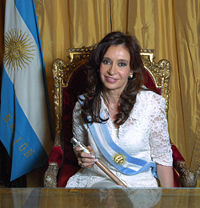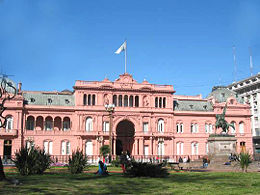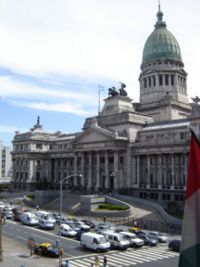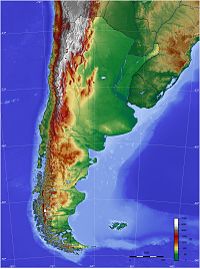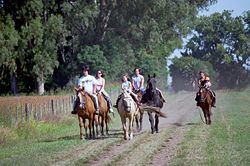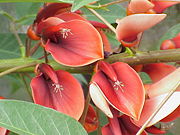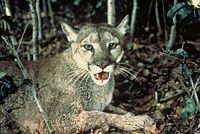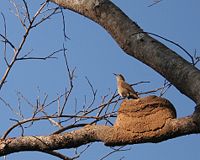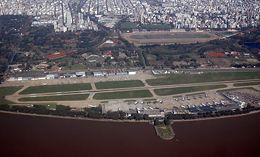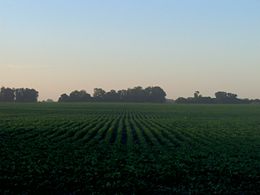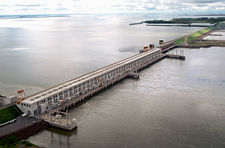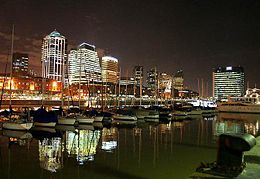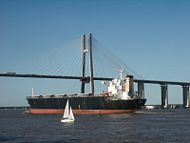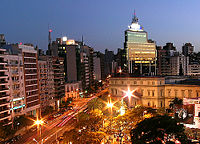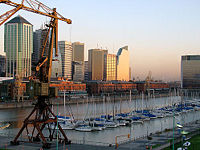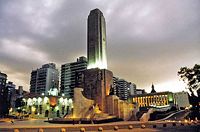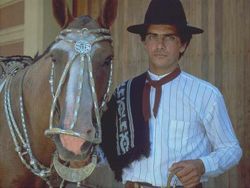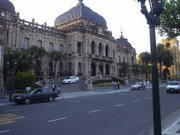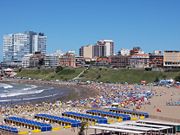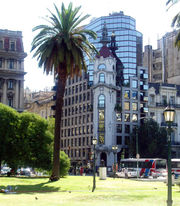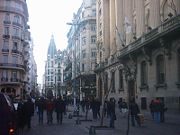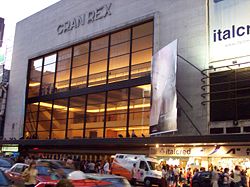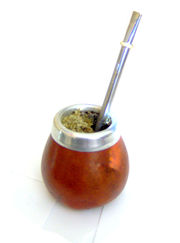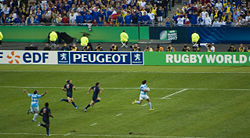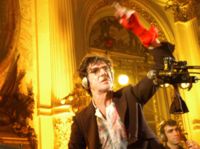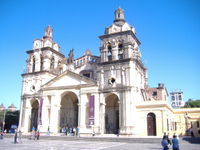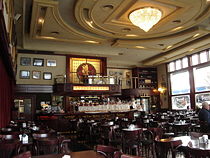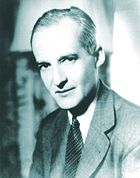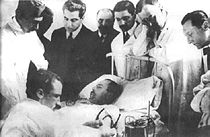Argentina
2008/9 Schools Wikipedia Selection. Related subjects: Americas; Countries
| República Argentina (Spanish) Argentine Republic
|
||||||
|---|---|---|---|---|---|---|
|
||||||
| Motto: En unión y libertad "In Union and Liberty" |
||||||
| Anthem: Himno Nacional Argentino |
||||||
|
|
||||||
| Capital (and largest city) |
Buenos Aires |
|||||
| Official languages | Spanish | |||||
| Ethnic groups | Spanish, Italian, German, Jewish, Arabs, Armenian, Irish, British, French, Native American, African | |||||
| Demonym | Argentine | |||||
| Government | Federal presidential republic | |||||
| - | President | Cristina Fernández de Kirchner | ||||
| - | Vice President | Julio Cobos | ||||
| Independence | from Spain | |||||
| - | May Revolution | 25 May 1810 | ||||
| - | Declared | 9 July 1816 | ||||
| Area | ||||||
| - | Total | 2,780,403 km² ( 8th) 1,078,757 sq mi |
||||
| - | Water (%) | 1.1 | ||||
| Population | ||||||
| - | 2008 estimate | 40,677,348 ( 30th) | ||||
| - | 2001 census | 36,260,130 | ||||
| GDP ( PPP) | 2007 estimate | |||||
| - | Total | $523.7 billion (2007) ( 23rd) | ||||
| - | Per capita | $13,307 (2007) ( 57th) | ||||
| GDP (nominal) | 2007 estimate | |||||
| - | Total | $260.7 billion ( 31st) | ||||
| - | Per capita | $6,548 ( 66th) | ||||
| Gini (2006) | 49 | |||||
| HDI (2005) | ▲ 0.869 (high) ( 38th) | |||||
| Currency | Peso ( ARS) |
|||||
| Time zone | ART ( UTC-3) | |||||
| - | Summer ( DST) | ART ( UTC-2) | ||||
| Internet TLD | .ar | |||||
| Calling code | +54 | |||||
| Argentina also has a territorial dispute with the United Kingdom over an additional 1,000,000 km² (386,102 sq mi) of Antarctica, the Falkland Islands and South Georgia and the South Sandwich Islands. | ||||||
Argentina (officially República Argentina Spanish pronunciation: [reˈpuβlika aɾxenˈtina]), is a South American country, constituted as a federation of twenty-three provinces and an autonomous city. It is second in size on the South American continent to Brazil and eighth in the world. Argentina occupies a continental surface area of 2,766,890 km² (1,068,302 sq mi) between the Andes mountain range in the west and the southern Atlantic Ocean in the east and south. It is bordered by Paraguay and Bolivia in the north, Brazil and Uruguay in the northeast, and Chile in the west and south. The country claims the British-administered overseas territories of the Falkland Islands and South Georgia and the South Sandwich Islands. Argentina also claims 969,464 km² (374,312 sq mi) of Antarctica, known as Argentine Antarctica, overlapping other claims made by Chile and the United Kingdom ( British Antarctic Territory).
Argentina has the highest Human Development Index level and the highest Gross Domestic Product (GDP) per capita in purchasing power parity in Latin America and its total national GDP is the 23rd largest in the world. The country is currently classified as an Upper-Middle Income Country or as a secondary emerging market by the World Bank. Argentina's nominal GDP makes it the 31st largest economy in the world.
Etymology
The name Argentina (from Latin argentum: silver) was first used extensively in the 1612 book Historia del descubrimiento, población, y conquista del Río de la Plata (History of the discovery, population, and conquest of the Río de la Plata) by Ruy Díaz de Guzmán, naming the territory Tierra Argentina (Land of Silver).
History
The first signs of human presence in Argentina are located in the Patagonia ( Piedra Museo, Santa Cruz), and date from 11,000 BC( Santa María, Huarpes, Diaguitas, Sanavirones, among others). In 1480, the Inca Empire under the rule of king Pachacutec launched an offensive and conquered present-day northwestern Argentina, integrating it into a region called Collasuyu. In the northeastern area, the Guaraní developed a culture based on yuca and sweet potato. The central and southern areas ( Pampas and Patagonia) were dominated by nomadic cultures, unified in the seventeenth century by the Mapuches.
European explorers arrived in 1516. Spain established a permanent colony on the site of Buenos Aires in 1580; the Viceroyalty of the Río de la Plata was created in 1776. During the early part of this period it was largely a country of Spanish immigrants and their descendants, known as criollos, some of them gathered in Buenos Aires and other cities, others living on the pampas as gauchos. Descendants of African slaves (See: Afro-Argentines) were present in significant numbers. Indigenous peoples inhabited much of the rest of Argentina. In 1806 and 1807 the British Empire launched two invasions to Buenos Aires, but the criollo population repelled both attempts. On May 25, 1810, after confirmation of the rumors about the overthrow of King Ferdinand VII by Napoleon, citizens of Buenos Aires created the First Government Junta ( May Revolution).Two nations emerged in what is now Argentina United Provinces of South America (1810) and Liga Federal (1815) Other provinces through the reluctance of some factions and the centralist tendencies of the more radical activists delayed a combined State. In the meantime, Paraguay declared its independence in 1811.
Military campaigns led by General José de San Martín between 1814 and 1817 made independence increasingly a reality. In 1820 Liga Federal was crushed by forces of the United Provinces of South America and Portugal armies from Brazil and its provinces absorbed into United Provinces of South America. Argentines revere San Martín, who campaigned in Argentina, Chile, and Peru, as the hero of their national independence. On July 9, 1816, a Congress gathered in Tucumán (the Congress of Tucumán) and finally issued a formal declaration of independence from Spain. Bolivia declared itself independent in 1825, and Uruguay was created in 1828 as a result of the Argentina-Brazil War. In 1818, General José de San Martín crossed the Andes to free Chile and Peru, thus eliminating the Spanish threat. Centralist and federalist groups (Spanish: Unitarios and Federales) were in conflict until national unity was established and the constitution promulgated in 1853. The constitution was strongly defended in moving oratory by the patriot and Franciscan Mamerto Esquiú, for whom one of the country's departments is named. From 1865 to 1870, the bloody War of Triple Alliance was fought by Argentina, Brazil, and Uruguay against Paraguay.
Foreign investment and immigration from Europe led to the adoption of modern agricultural techniques. In the 1870s, the " Conquest of the Desert" subdued the remaining indigenous tribes throughout the southern Pampas and Patagonia, leaving 1,300 indigenous dead.
From 1880 to 1929, Argentina enjoyed increasing prosperity and prominence while emerging as one of the 10 richest countries in the world, benefiting from an agricultural export-led economy. The population of the country swelled sevenfold. Conservative forces dominated Argentine politics through non-democratic means until 1916, when their traditional rivals, the Radicals, won control of the first free-elected government. The military forced Hipólito Yrigoyen from power in 1930, leading to another decade of Conservative rule. The country was neutral during World War II. Political change led to the presidency of Juan Perón in 1946, who worked to empower the working class and greatly expanded the number of unionized workers. Perón's wife, Maria Eva Duarte de Perón (better known as Evita) played an important role as First Lady during both Peronist administrations. She was the driving force of power behind Perón's success among the working class people and quickly became an enigma that is still researched today. Being born into poverty herself, Evita never forgot the hardships her family endured during her childhood. She quickly created the Eva Perón Foundation which provided several services and needs to the working poor of Argentina such as basic items like pots and pans, sewing machines, and even fully furnished houses. The foundation built hundreds of schools, hospitals, orphanages and even Evita City which still stands today as an active neighbourhood.
This was the first time the country had seen such a shift in attention to aiding the poor and it did not sit well with the oligarchy. Evita was seen as the "bridge of love" between Perón and the people and she was. She fought for and won the fight for women's suffrage and organized the Perónist Feminist Party. Throughout Perón's first and second term as president, the economy turned to more protectionist policies and the developing of industry. Things began to change; however, and not for the better. After Evita's untimely death at the age of 33 in 1952 from uterine cancer, Perón gradually started to lose his footing among the people and eventually his administration began to fall apart. The Revolución Libertadora of 1955 deposed him in a coup, and he fled into exile to live in Spain. Little did anyone know at the time he would return to Argentina after several years of exile to become president again.
From the 1950s to 1970s, moderate military and weak civilian administrations traded power. During those years the economy grew strongly and poverty declined (to less than 7% in 1975). At the same time political violence continued to escalate, fighting against the military government, demanding the return of Perón from his Spanish exile. In 1973, Perón returned to the presidency, but he died within a year of assuming power. His third wife Isabel, the Vice President, succeeded him in office, but the military coup of March 24, 1976 removed her from office.
The armed forces took power through a junta in charge of the self-appointed National Reorganization Process until 1983. The military government repressed opposition and leftist groups using harsh illegal measures (the " Dirty War"); thousands of dissidents " disappeared", while the SIDE cooperated with DINA and other South American intelligence agencies, and with the CIA in Operation Condor. Many of the military leaders that took part in the Dirty War were trained in the U.S.-financed School of the Americas, among them Argentine dictators Leopoldo Galtieri and Roberto Viola. The military dictatorship (1976-1983) built several public facilities but largely increased the extent of the country's foreign debt. From that point the economy of the country began to be controlled more and more by the conditions imposed on it by both its creditors and the IMF (International Monetary Fund) with priority given to servicing the repayment of the foreign debt. These and other economic problems, charges of corruption, public revulsion in the face of human rights abuses and, finally, the country's 1982 defeat by the British in the Falklands War discredited the Argentine military regime.
Democracy was restored in 1983. Raúl Alfonsín's government took steps to account for the "disappeared", established civilian control of the armed forces, and consolidated democratic institutions. The members of the three military juntas were prosecuted and sentenced to life terms. Failure to resolve endemic economic problems and an inability to maintain public confidence led to Alfonsín's early departure six months before his term was to be completed.
The 1990s began with hyperinflation. President Carlos Menem imposed a peso-dollar fixed exchange rate in 1991 to stop hyperinflation and adopted far-reaching market-based policies, dismantling protectionist barriers and business regulations, and implementing a privatization program. These reforms contributed to significant increases in investment and growth with stable prices through most of the 1990s. However, the peso was tied to the dollar at an artificially high rate that could only be maintained by flooding the market with dollars. As a result the foreign debt increased enormously and state companies and services were privatized. The total opening up of the market to foreign goods, which up until then were produced locally, resulted in the collapse of local industry. So while part of the population was saving in dollars, traveling overseas, and purchasing imported and luxury goods cheaply, the rest of the population was experiencing an increase in both poverty and unemployment. The IMF and the world economists praised the liberalization of the Argentine market, and the country was presented as a “model student”. Toward the end of the 1990s, large fiscal deficits and overvaluation of the pegged peso caused a gradual slide into economic crisis. In 1998 a period of profound economic recession began. This was a direct result of the economic measures which dominated the decade of the 90s and which produced a false sense of stability and well being. By the end of his term in 1999, these accumulating problems and perceived corruption had made Menem unpopular.
The Menem and de la Rúa administrations faced diminished competitiveness in exports, massive imports which damaged national industry and reduced employment, chronic fiscal and trade deficits, and the contagion of several economic crises. Unemployment reached as high as 25% of the economically active population, and another 15% had only part-time work. The Asian financial crisis in 1998 precipitated an outflow of capital that mushroomed into a recession, and culminated in economic crisis in November 2001. The governing coalition was forced to undertake a series of measures including the freezing of bank accounts. This was done to halt the flow of capital out of the country and to stem the growing debt crisis. However, a climate of popular discontent was unleashed as a result. On 20 December 2001 Argentina was thrown into its worst institutional and economic crisis for several decades. There were violent street protests, which brought about clashes with the police and resulted in several fatalities. The increasingly chaotic climate, amidst bloody riots, finally resulted in the resignation of President de la Rúa. The economic crisis accentuated the people's lack of trust in their politicians. During this time street protests were accompanied by the cry “they all should go.” The "they" referred to the politicians, especially those involved in many reported acts of corruption. They were also accused of dealing fraudulently with public goods and money, without any judicial sanctions in place to curb the corruption.
In two weeks, several presidents followed in quick succession, culminating in Eduardo Duhalde's being appointed interim President of Argentina by the Legislative Assembly on 2 January 2002. Argentina defaulted on its international debt obligations. The peso's near eleven year-old linkage to the United States dollar was abandoned, resulting in major depreciation of the peso and a spike in inflation. Duhalde, a peronist with a centre-left economic position, had to cope with several problems inherited from De La Rua´s shaky government.
With a more competitive and flexible exchange rate, the country implemented new policies based on re-industrialization, import substitution, increased exports, and consistent fiscal and trade surpluses. By the end of 2002 the economy began to stabilize, mainly thanks to the soybean and other cereals' boom and floating of exchange rates. In 2003, Néstor Kirchner was elected president. During Kirchner's presidency, Argentina restructured its defaulted debt with a steep discount (about 66 percent) on most bonds, paid off debts with the International Monetary Fund, renegotiated contracts with utilities, and nationalized some previously privatized enterprises. Currently, Argentina is enjoying a period of economic growth. In 2007 Cristina Fernández de Kirchner, was elected president, becoming the first woman to be elected president of Argentina. Also in 2007, Centre-left Fabiana Ríos ( ARI) became the first woman to be elected governor of Tierra del Fuego and first elected female governor in Argentina's history.
Politics
Government
Argentina's political framework is a federal presidential representative democratic republic, in which the President of The Argentine Nation is both head of state and head of government, complemented by a pluriform multi-party system. The current president (2007) is Cristina Fernández de Kirchner, with Julio Cobos as vice president.
The Argentine Constitution of 1853 mandates a separation of powers into executive, legislative, and judicial branches at the national and provincial level.
Executive power resides in the President and his or her cabinet. The President of The Argentine Nation and Vice President are directly elected to four-year terms, limited to two consecutive terms, and the cabinet ministers are appointed by the president.
Legislative power is vested in the bicameral National Congress or Congreso de la Nación, consisting of a Senate ( Senado) of seventy-two seats, and a Chamber of Deputies ( Cámara de Diputados) of 257 members.
Senators serve six-year terms, with one-third standing for reelection every two years. Members of the Chamber of Deputies are directly elected to four-year term via a system of proportional representation, with half of the members of the lower house being elected every two years. A third of the candidates presented by the parties must be women.
The judiciary is independent of the executive and the legislature. The Argentine Supreme Court of Justice has seven members who are appointed by the President in consultation with the Senate. The rest of the judges are appointed by the Council of Magistrates of the Nation, a secretariat composed of representatives of judges, lawyers, the Congress, and the executive (see Law of Argentina).
Argentina is a member of an international block, Mercosur, which has some legislative supranational functions. Mercosur is composed of five full members: Argentina, Brazil, Paraguay, Uruguay, and Venezuela. It has five associate members without full voting rights: Bolivia, Chile, Colombia, Ecuador, and Peru.
Argentina was the only country from Latin America to participate in the 1991 Gulf War under mandate of the United Nations. It was also the only Latin American country involved in every phase of the Haiti operation. Argentina has contributed worldwide to peacekeeping operations, including in El Salvador-Honduras-Nicaragua, Guatemala, Ecuador-Peru, Western Sahara, Angola, Kuwait, Cyprus, Croatia, Kosovo, Bosnia and Timor Leste. In recognition of its contributions to international security, U.S. President Bill Clinton designated Argentina as a major non-NATO ally in January 1998. In 2005, it was elected as a temporary member of the UN Security Council.
In 1993, Argentina launched the United Nations White Helmets indicative of humanitarian aid.
On November 4- November 5, 2005, the Argentine city of Mar del Plata hosted the Fourth Summit of the Americas. This summit was marked by a number of anti-U.S. protests. As of 2006, Argentina has been emphasizing Mercosur as its first international priority; by contrast, during the 1990s, it relied more heavily on its relationship with the United States.
Argentina has long claimed sovereignty over the Falkland Islands (Islas Malvinas), the South Shetland Islands, the South Sandwich Islands and almost 1 million km² in Antarctica, between the 25°W and the 74°W meridians and the 60°S parallel. For more than a century, there has been an Argentine presence at the Orcadas Base.
Argentina is a founding signatory and permanent consulting member of the Antarctic Treaty System and the Antarctic Treaty Secretariat is established in Buenos Aires.
Military
Argentina's armed forces are controlled by the Defense Ministry, with the country's President as their Commander-in-Chief. Historically, Argentina's military has been one of the best equipped in the region (for example, developing its own advanced jet fighters as early as the 1950s), but has faced expenditure cutbacks in comparison to other regional militaries. The age of allowable military service is 18 years; there is no obligatory military service and currently no conscription.
The armed forces are composed of a traditional Army, Navy, and Air Force. Controlled by a separate ministry (the Interior Ministry), Argentine territorial waters are patrolled by the Naval Prefecture, and the border regions by the National Gendarmerie; both arms however maintain liaison with the Defense Ministry. Argentina's Armed Forces are currently undertaking major operations in Haiti and Cyprus, in accordance with UN mandates.
Provinces

Argentina is divided into twenty-three provinces (provincias; singular provincia), and one autonomous city (commonly known as the capital federal, but officially Ciudad Autónoma de Buenos Aires):
|
1. Buenos Aires (autonomous city) 2. Buenos Aires (province) 3. Catamarca 4. Chaco 5. Chubut 6. Córdoba 7. Corrientes 8. Entre Ríos 9. Formosa 10. Jujuy 11. La Pampa 12. La Rioja |
13. Mendoza 14. Misiones 15. Neuquén 16. Río Negro 17. Salta 18. San Juan 19. San Luis 20. Santa Cruz 21. Santa Fe 22. Santiago del Estero 23. Tierra del Fuego 24. Tucumán |
|
Though declared the capital in 1853, Buenos Aires didn't become the capital of the country until 1880. There have been moves to relocate the administrative centre elsewhere. During the presidency of Raúl Alfonsín, a law was passed ordering the transfer of the federal capital to Viedma, a city in the Patagonian province of Río Negro. Studies were underway when economic problems halted the project in 1989. Though the law was never formally repealed, it is now treated as a relic.
Provinces are divided into smaller secondary units called departamentos ("departments"), of which there are 376 in total. The province of Buenos Aires has 134 similar divisions known as partidos. Departamentos and partidos are further subdivided into municipalities or districts.
In descending order by number of inhabitants, the major cities in Argentina are Buenos Aires, Córdoba, Rosario, Mendoza, Tucumán, La Plata, Mar del Plata, Salta, Santa Fe, San Juan, Resistencia, and Neuquén.
Geography
Main features
The total surface area of Argentina (not including the Antarctic claim) is as follows:
- Total: 2,766,891 km²
- Land: 2,736,691 km²
- Water: 30,200 km²
Argentina is about 3,330 km (about 2,070 mi) long from north to south, and 1,400 km (about 870 mi) from east to west (maximum values). It can roughly be divided into four parts: the fertile plains of the Pampas in the centre of the country, the source of Argentina's agricultural wealth; the flat to rolling, oil-rich plateau of Patagonia in the southern half down to Tierra del Fuego; the subtropical flats of the Gran Chaco in the north, and the rugged Andes mountain range along the western border with Chile.
The highest point above sea level in Argentina is located in Mendoza. Cerro Aconcagua, at 6,962 meters (22,834 feet), is the highest mountain in the Americas, the Southern, and Western Hemisphere. The lowest point is Laguna del Carbón in Santa Cruz, −105 meters (−344 ft) below sea level. This is also the lowest point on the South American continent. The geographic centre of the country is located in south-central La Pampa province.
The country has a territorial claim over a portion of Antarctica (unrecognized by any other country), where, from 1904, it has maintained a constant presence.
Geographic regions
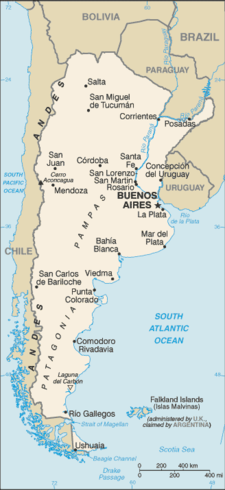
The country is traditionally divided into several major geographically distinct regions:
- Pampas
- The plains west and south from Buenos Aires. Called the Humid Pampa, they cover most of the provinces of Buenos Aires and Córdoba, and big portions of the provinces of Santa Fe and La Pampa. The western part of La Pampa and the province San Luis also have plains (the Dry Pampa), but they are drier and used mainly for grazing. The Sierra de Córdoba in the homonymous province (extending into San Luis), is the most important geographical feature of the pampas.
- Gran Chaco
- The Gran Chaco region in the north of the country is seasonal dry/wet, mainly cotton growing and livestock raising. It covers the provinces of Chaco and Formosa. It is dotted with subtropical forests, scrubland, and some wetlands, home to a large number of plant and animal species. The province of Santiago del Estero lies in the drier region of the Gran Chaco.
- Mesopotamia
- The land between the Paraná and Uruguay rivers is called Mesopotamia and it is shared by the provinces of Corrientes and Entre Ríos. It features flatland apt for grazing and plant growing, and the Iberá Wetlands in central Corrientes. Misiones province is more tropical and belongs within the Brazilian Highlands geographic feature. It features subtropical rainforests and the Iguazú Falls.
- Patagonia
- The steppes of Patagonia, in the provinces of Neuquén, Río Negro, Chubut and Santa Cruz, are of Tertiary origin. Most of the region is semiarid in the north to cold and arid in the far south, but forests grow in its western fringes which are dotted with several large lakes. Tierra del Fuego is cool and wet, moderated by oceanic influences. Northern Patagonia (roughly Río Negro south of the homonymous river, and Neuquén) can also be referred as the Comahue region.
- Cuyo
- West-central Argentina is dominated by the imposing Andes Mountains. To their east is the arid region known as Cuyo. Melting waters from high in the mountains form the backbone of irrigated lowland oasis, at the centre of a rich fruit and wine growing region in Mendoza and San Juan provinces. Further north the region gets hotter and drier with more geographical accidents in La Rioja province.
- NOA or Northwest
- This region is the highest in average elevation. Several parallel mountain ranges, several of which have peaks higher than 20,000 feet (6,000 m), dominate the area. These ranges grow wider in geographic extent towards the north. They are cut by fertile river valleys, the most important being the Calchaquí Valleys in the provinces of Catamarca, Tucumán, and Salta. Farther north the province of Jujuy near Bolivia lies mainly within the Altiplano plateau of the Central Andes. The Tropic of Capricorn goes through the far north of the region.
Rivers and lakes
Major rivers in Argentina include the Pilcomayo, Paraguay, Bermejo, Colorado, Río Negro, Salado, Uruguay and the largest river, the Paraná. The latter two flow together before meeting the Atlantic Ocean, forming the estuary of the Río de la Plata. Regionally important rivers are the Atuel and Mendoza in the homonymous province, the Chubut in Patagonia, the Río Grande in Jujuy, and the San Francisco River in Salta.
There are several large lakes in Argentina, many of them in Patagonia. Among these are lakes Argentino and Viedma in Santa Cruz, Nahuel Huapi in Río Negro and Fagnano in Tierra del Fuego, and Colhué Huapi and Musters in Chubut. Lake Buenos Aires and O'Higgins/San Martín Lake are shared with Chile. Mar Chiquita, Córdoba, is the largest salt water lake in the country. There are numerous reservoirs created by dams. Argentina features various hot springs, such as those at Termas de Río Hondo with temperatures between 89 °C and 65 °C.
Coastal areas and seas
Argentina has 4,665 km (2,899 mi) of coastline. The continental platform is unusually wide; in Argentina this shallow area of the Atlantic Ocean is called Mar Argentino. The waters are rich in fisheries and suspected of holding important hydrocarbon energy resources. Argentina's coastline varies between areas of sand dunes and cliffs. The two major ocean currents affecting the coast are the warm Brazil Current and the cold Falkland Current (Spanish: corriente antártica or corriente de las Malvinas). Because of the uneveness of the coastal landmass, the two currents alternate in their influence on climate and do not allow temperatures to fall evenly with higher latitude. The southern coast of Tierra del Fuego forms the north shore of the Drake Passage.
Climate
Because of longitudinal and elevation amplitudes, Argentina is subject to a variety of climates. As a rule, the climate is predominantly temperate with extremes ranging from subtropical in the north to subpolar in the far south. The north of the country is characterized by very hot, humid summers with mild drier winters, and is subject to periodic droughts. Central Argentina has hot summers with thunderstorms (in western Argentina producing some of the world's largest hail), and cool winters. The southern regions have warm summers and cold winters with heavy snowfall, especially in mountainous zones. Higher elevations at all latitudes experience cooler conditions.
The hottest and coldest temperature extremes recorded in South America have occurred in Argentina. A record high temperature of 49.1 °C (120.4 °F), was recorded at Villa de María, Córdoba on January 2, 1920. The lowest temperature recorded was −39 °C (−38.2 °F) at Valle de los Patos Superior, San Juan, July 17, 1972.
Major winds in Argentina include the cool Pampero blowing on the flat plains of Patagonia and the Pampas after a cold front; the Viento Norte, a warm wind that can blow from the north in mid and late winter creating mild conditions; and the Zonda, a hot and dry wind (see also foehn wind), affecting west-central Argentina. Squeezed of all moisture during the 6,000 meter descent from the Andes, Zonda winds can blow for hours with gusts up to 120 km/h, fueling wildfires and causing damage. When the Zonda blows (June-November), snowstorms and blizzard (viento blanco) conditions usually affect the higher elevations.
The Sudestada (literally “southeastern”) could be considered similar to the Noreaster, though snowfall is rarely involved (but is not unprecedented). Both are associated with a deep winter low pressure system. The sudestada usually moderates cold temperatures but brings very heavy rains, rough seas, and coastal flooding. It is most common in late autumn and winter along the coasts of central Argentina and in the Río de la Plata estuary.
The southern regions, particularly the far south, experience long periods of daylight from November to February (up to nineteen hours), and extended nights from May to August. All of Argentina uses UTC-3 time zone. The country does observe daylight saving time occasionally, the last summertime being started at 0:00 December 30, 2007 and being finished at 0:00 March 16, 2008.
Extremities Argentina's eastermost continental point is northeast of the town of Bernardo de Irigoyen, Misiones (), the westernmost in the Mariano Moreno Range in Santa Cruz (). The northernmost point is located at the confluence of the Grande de San Juan and Mojinete rivers, Jujuy (), and the southernmost is Cape San Pío in Tierra del Fuego ().
Enclaves and exclaves
There is one Argentine exclave, the Martín García Island (co-ordinates ). It is near the confluence of the Paraná and Uruguay rivers, a kilometer (0.62 mi) inside Uruguayan waters, and 3.5 kilometres (2.1 mi) from the Uruguayan coastline near the small town of Martín Chico (itself halfway between Nueva Palmira and Colonia del Sacramento).
An agreement reached by Argentina and Uruguay in 1973 reaffirmed Argentine jurisdiction over the island, ending a century-old dispute. Under the terms of the agreement, Martín García is to be devoted exclusively as a natural preserve. Its area is about 2 square kilometres (500 acres), and its population is about 200 people.
Flora
Subtropical plants dominate the north, part of the Gran Chaco region of South America. The genus Dalbergia of trees is well disseminated with representatives like the Brazilian Rosewood and the quebracho tree; also predominant are white and black algarrobo trees ( prosopis alba and prosopis nigra). Savannah-like areas exist in the drier regions nearer the Andes. Aquatic plants thrive in the wetlands dotting the region.
In central Argentina the humid pampas are a true tallgrass prairie ecosystem. The original pampa had virtually no trees; today along roads or in towns and country estates (estancias), some imported species like the American sycamore or eucalyptus are present. The only tree-like plant native to the pampa is the ombú, an evergreen. The surface soils of the pampa are a deep black colour, primarily humus, known commonly as compost. It is this which makes the region one of the most agriculturaly productive on Earth. However, this is also responsible for decimating much of the original ecosystem, to make way for commercial agriculture. The western pampas receive less rainfall, this dry pampa is a plain of short grasses or steppe.
Most of Patagonia in the south lies within the rain shadow of the Andes. The flora, shrubby bushes and plants, is well suited to withstand dry conditions. The soil is hard and rocky, making large-scale farming impossible except along river valleys. Coniferous forests grow in far western Patagonia and on the island of Tierra del Fuego. Conifers native to the region include alerce (Fitzroya cupressoides), ciprés de la cordillera (Austrocedrus chilensis), ciprés de las guaitecas (Pilgerodendron uviferum), huililahuán (Podocarpus nubigenus), lleuque (Prumnopitys andina), mañío hembra (Saxegothaea conspicua), and pehuén (Araucaria araucana), while native broadleaf trees include several species of Nothofagus including coigüe or coihue, lenga (Nothofagus pumilio), ñire (Nothofagus Antarctica). Other introduced trees present in forestry plantations include spruce, cypress, and pine. Common plants are the copihue and colihue ( Chusquea culeou).
In Cuyo, semiarid thorny bushes and other xerophile plants abound. Along the many river oasis, grasses and trees grow in significant numbers. The area presents optimal conditions for the large scale growth of grape vines. In the northwest of Argentina there are many species of cacti. In the highest elevations (often above 4,000mts), no vegetation grows because of the extreme altitude, and the soils are virtually devoid of any plant life.
The ceibo flower, of the tree Erythrina crista-galli, is the national flower of Argentina.
Fauna
Many species live in the subtropical north. Big cats like the jaguar, cougar, and ocelot; primates ( howler monkey); large reptiles (crocodiles), and a species of caiman. Other animals include the tapir, capybara, peccary, bush dog, raccoon, and various species of turtle and tortoise. There are many birds, notably hummingbirds, flamingos, toucans, and parrots.
The central grasslands are populated by the giant anteater, armadillo, pampas cat, maned wolf, mara and the rhea (ñandú), a flightless bird. Hawks, falcons, herons, tinamous (Argentine "partridges" or "perdiz") inhabit the region. There are also deer and foxes. Some of these species extend into Patagonia.
The western mountains are home to different animals. These include the llama, guanaco, vicuña, among the most recognizable species of South America. Also in this region are the fox, viscacha, Andean Mountain Cat, kodkod and the largest flying bird in the New World, the Andean Condor.
Southern Argentina is home to the cougar, huemul, pudú (the world's smallest deer), and introduced, non-native wild boar. The coast of Patagonia is rich in animal life: elephant seals, fur seals, sea lions, and species of penguin. The far south is populated by cormorant birds.
The territorial waters of Argentina have abundant ocean life; mammals such as dolphins, orcas, and whales like the southern right whale, a major tourist draw for naturalists. Sea fish include sardines, argentine hakes, dolphinfish, salmon, and sharks; also present are squid and spider crab (centolla) in Tierra del Fuego. Rivers and streams in Argentina have many species of trout and the South American dorado fish. Outstanding snake species inhabiting Argentina include boa constrictors, and the very venomous yarará pit viper and South American rattle snake.
The Hornero was elected the National Bird after a survey in 1928.
Economy
Argentina benefits from abundant natural resources, a highly literate population, an export-oriented agricultural sector, and a diversified industrial base, that was once one of the wealthiest nations with a large middle class but this segment of the population has suffered by a succession of economic crises.
Argentina's economy started to slowly lose ground after 1945 when it went from a wealthy nation with a strong and prosperous economy to a deep recession in the mid 50s, losing its place in the position of prosperous industrialized nations. The economy further declined during the military dictatorship that lasted from 1976 to 1983.
During this period, the government took out large loans with high interest rates from the IMF and private banking institutions. The country engaged in a disorganized and corrupt rapid liberalization that marked the end of its industrial hegemony in Latin America. During the military dictatorship over 400,000 companies of all sizes went bankrupt. The economic decisions made from 1983 till 2001 failed to revert the situation. Finally, in 2001, after 3 years of recession, the economy broke down and reached its worst point in history.
Although significant since then, the result is that, today, while a significant segment of the population is still financially well-off, they stand in sharp contrast with the millions who have seen their purchasing power drastically reduced. Since 2002, there has been an improvement in the situation of the poorer sectors and a strong rebound of the middle class.
The urban poverty rate dropped to 23% by 2007, down from the peak observed in 2003, but is still above the level prior to the recession. From the late 1970s the country piled up public debt and was plagued by bouts of high inflation. In 1991, the government pegged the peso to the U.S. dollar and limited the growth in the money supply. It then embarked on a path of trade liberalization, deregulation and privatization. Inflation dropped and gross domestic product grew, but external economic shocks and failures of the system diluted benefits, causing the economy to crumble slowly from 1995 until the collapse in 2001.
By 2002, Argentina had defaulted on its debt, its GDP had shrunk, unemployment was more than 25%, and the peso had depreciated 75% after being devalued and floated. However, careful spending control and heavy taxes on then-soaring exports allowed the state to regain resources and conduct monetary policy.
In 2003, import substitution policies and soaring exports, coupled with lower inflation and expansive economic measures, triggered a surge in the GDP. This was repeated in 2004 and 2005, creating millions of jobs and encouraging internal consumption. Capital flight decreased, and foreign investment slowly returned. An influx of foreign currency from exports created a huge trade surplus. The Central Bank was forced to buy dollars from the market, and continues to do so from time to time to prevent the Argentine peso from appreciating significantly and cutting competitiveness.
The situation by 2006 was further improved. The economy grew 8.8% in 2003, 9.0% in 2004, 9.2% in 2005, 8.5% in 2006, and 8.7% in 2007, though inflation, estimated at around 12 to 15% (official numbers are 9.8% for 2006), has become an issue again, and income distribution is still considerably unequal.
Sectors
Argentina is one of the world's major agricultural producers, ranking third worldwide in production of soybeans, fifth in maize, and eleventh in wheat. In 2007, agricultural output accounted for 10% of GDP, and nearly one third of all exports. Soy and vegetable oils are major export commodities at 32% of exports. Wheat, maize, oats, sorghum, and sunflower seeds totalled 7%. Cattle is also a major industry. Beef, milk, leather products, and cheese were 6% of total exports. Sheep and wool industries are important in Patagonia, pigs and caprines elsewhere.
Fruits and vegetables made up 4% of exports: apples and pears in the Río Negro valley; oranges and other citrus in the northwest and Mesopotamia; grapes and strawberries in Cuyo, and berries in the far south. Cotton and yerba mate are major crops in the Gran Chaco, sugarcane and tobacco in the northwest, and olives and garlic in Cuyo. Bananas ( Formosa), tomatoes ( Salta), and peaches (Mendoza) are grown for domestic consumption. Argentina is the world's fifth-largest wine producer, and fine wine production has taken major leaps in quality. A growing export, total viticulture potential is far from met. Mendoza is the largest wine region, followed by San Juan. As a strike by farmers, who are protesting an increase in export taxes for their products, continued for a 13th day March 25, 2008 with no solution in sight, butchers and supermarkets were among the first hit.
Industrial petrochemicals, oil, and natural gas are Argentina's second group of exports, 20% of totals. The most important oil fields lie in Patagonia and Cuyo. An impressive network of pipelines send raw product to Bahia Blanca, centre of the petrochemical industry, and to the La Plata- Rosario industrial belt. Coal is also mined.
Mining is a growing industry. The northwest and San Juan Province are main regions of activity. Metals mined include gold, silver, zinc, magnesium, copper, sulfur, tungsten and uranium. In only ten years exports soared from US$ 200 million to 1.2 billion in 2004, 3% of total. Estimates for 2006 are US$ 2bn, a 10 fold rise from 1996.
In fisheries, argentine hake accounts for 50% of catches, pollack and squid follow. Forestry has expanded in Mesopotamia; elm for cellulose, pine and eucalyptus for furniture, timber, and paper products. Both sectors each account for 2% of exports.
Manufacturing is the nation's largest single sector in the economy, with 22% of GDP. Leading sectors are motor vehicles, auto parts, and transportation and farming equipment (7% of exports), iron and steel (3%), foodstuffs and textiles (2%). Other manufactures include cement, industrial chemicals, home appliances, and processed wood. The biggest industrial centers are Buenos Aires, Rosario and Córdoba.
The telecommunication sector has been growing at a fast pace, with an important penetration of mobile telephony (More than 75% of the population)internet (with more than 16 million people online), and broadband services (4.1%). Regular telephone (with 9.5 million lines) and mail are robust.
Argentina produces energy in large part through well developed hydroelectric resources; nuclear energy is also of high importance. The country is one of the largest producers and exporters (with Canada and Russia) of Cobalt-60, a radioactive isotope widely used in cancer therapy. Construction has led employment creation in the current economic expansion and is 6% of GDP.
The service sector is the biggest contributor to total GDP, accounting for 58%. Argentina enjoys a diversified service sector, which includes well-developed social, corporate, financial, insurance, real-estate, transport and communication services, as well as vigorous commercial and tourist trades.
Tourism is increasingly important, now providing 7% of economic output. Argentines are traveling more within their borders, and foreigners are flocking to a country seen as affordable, safe, and incredibly diverse: Cosmopolitan Buenos Aires and Rosario; the Iguazu Falls and colonial Salta; the South American indigenous Jujuy Province and fun-filled Córdoba; the wineries of Mendoza; the ski-suitable scenic Bariloche to the beaches of Pinamar; and Perito Moreno Glacier to Tierra del Fuego. 3.7 million tourists visited in 2005.
Transportation
Argentina's infrastructure is advanced compared to other countries in Latin America. There are nearly 215,471 km (133,887 mi) of roads of which 68,809 km are paved, and 734 km are expressways, many of which are privatized. Multilane highways now connect several main cities and more are now under construction.
The railway network has a total length of 31,902 km. After decades of decaying service and lack of maintenance, most passenger services shut down in 1992 when the rail company was privatized, and thousands of kilometers of track are now in disrepair. Railway services are currently being reactivated among several cities.
The country has around 3,000 kilometers of waterways, the most significant among these being the Río de la Plata, Paraná, Uruguay, Río Negro and Paraguay rivers.
Water supply and sanitation
Water supply and sanitation in Argentina faces five key challenges: (i) low coverage with higher levels of service provision for its income level; (ii) poor service quality; and (iii) high levels of pollution; (iv) low cost recovery; and (v) unclear allocation of responsibilities between institutions in the sector.
Population
Contemporary figures
The National Institute of Statistics and Census of Argentina (INDEC) 2001 census showed the population of Argentina was 36,260,130. It ranks third in South America in total population and 30th globally. The 2008 estimate is 40,677,348. Argentina's population density is 15 inhabitants per square kilometer of land area; however, the population is not evenly distributed: areas of the city of Buenos Aires have a population density of over 14,000 inhab./km², while Santa Cruz province has fewer than 1 inhab./km². Argentina is the only nation in South America with a net positive migration rate; about +0.4 net immigrants per 1000 locals, yearly.
Cities and metropolitan areas
As of 2005, Argentina's 20th largest metropolitan areas are:
| Rank | City | Province | Population | Region |
|---|---|---|---|---|
| 1 | Buenos Aires | City + 24 partidos in Buenos Aires Province | 13,052,177 | Pampean |
| 2 | Córdoba | Córdoba | 1,513,200 | Pampean |
| 3 | Rosario | Santa Fe | 1,295,100 | Pampean |
| 4 | Mendoza | Mendoza | 1,009,100 | Cuyo |
| 5 | La Plata | Buenos Aires | 857,800 | Pampean |
| 6 | San Miguel de Tucumán | Tucumán | 833,100 | NOA (northwest) |
| 7 | Mar del Plata | Buenos Aires | 699,600 | Pampean |
| 8 | Salta | Salta | 530,400 | NOA (northwest) |
| 9 | Santa Fe | Santa Fe | 525,300 | Pampean |
| 10 | San Juan | San Juan | 456,400 | Cuyo |
| 11 | San Salvador | Jujuy | 400,000 | NOA (northwest) |
| 12 | Resistencia | Chaco | 399,800 | Gran Chaco |
| 13 | Neuquén | Neuquén | 391,600 | Patagonian |
| 14 | Santiago del Estero | Santiago del Estero | 389,200 | Gran Chaco |
| 15 | Corrientes | Corrientes | 332,400 | Mesopotamia |
| 16 | Bahía Blanca | Buenos Aires | 310,200 | Pampean |
| 17 | Río Cuarto | Cordoba | 144,021 | Pampean |
| 18 | Comodoro Rivadavia | Chubut | 140,628 | Patagonia |
| 19 | Santa Rosa | La Pampa | 110,640 | Pampean |
| 20 | Zárate | Buenos Aires | 101,271 | Pampean |
| 21 | Tandil | Buenos Aires | 101,010 | Pampean |
Demographics
Ethnicity
Argentina, along with other areas of new settlement like Canada, Australia, or New Zealand is considered a country of immigrants and a melting pot of different peoples, both autochthonous and immigrants. Most Argentines are descendents of colonial-era settlers and of the 19th and 20th century immigrants from Europe, with almost 90% of the population being of European descent. For generations the majority of these immigrants came mainly from Italy and Spain as well as other European countries. The last national census, based on self-identification, showed that only 2% of the population identified as Amerindian, and the mestizo population makes up over 8.6%. A study conducted by the University of Buenos Aires showed that over 56% of the population has some degree of Amerindian admixture on either paternal or maternal lineages, and about 10% were shown to have Amerindian ancestors on both lineages.
After the Spanish colonists, waves of European settlers migrated to Argentina from the late nineteenth to mid-twentieth centuries. Major contributors included Italy (initially from Piedmont, Veneto, and Lombardy, later from Campania and Calabria), Spain (foremost among them Galicians and Basques, and France (mostly to Buenos Aires and Mendoza). Smaller but significant numbers of immigrants came from Germany and Switzerland (to the Lakes Region of Patagonia; and to Córdoba), Denmark, Norway, Sweden, Greece, Lebanon, the United Kingdom, Ireland (to Buenos Aires, Santa Fé, and Patagonia; see also English settlement in Argentina), and Portugal. Eastern Europeans were also numerous from Russia, Ukraine, and Lithuania and from Central Europe (Croatia (ex. President of Argentina Néstor Kirchner is of Croatian descent), Slovenia, Hungary, Poland, Romania), as well as Balkan countries (Serbia and Montenegro, particularly in Chaco). There is a large Armenian community, and the Patagonian Chubut Valley has a significant Welsh-descended population.
Minorities
Small but growing numbers of people from East Asia have also settled in Argentina, mainly in Buenos Aires. The first Asian-Argentines were of Japanese descent; Koreans, Vietnamese, and Chinese followed, now at over 60,000.
The majority of Argentina's Jewish community are Ashkenazi Jews while about 15–20% from Sephardic groups from Syria. Argentina is home to the fifth largest Ashkenazi Jewish community in the world. (See also History of the Jews in Argentina) Argentina has a large Arab community, made up mostly of immigrants from Syria and Lebanon. Many have gained prominent status in national business and politics, including former president Carlos Menem, the son of Syrian settlers from the province of La Rioja. Most of the Arab Argentines are Christian of the Eastern Orthodox and Eastern Catholic Churches.
The officially recognized indigenous population in the country, according to the "Complementary Survey of Indigenous Peoples" based on 2001 Census data, stands at approximately 402,921 people (about 1 percent of the total population)
Illegal immigrants
Illegal immigration has been a recent factor in Argentine demographics. Most illegal immigrants come from Bolivia and Paraguay, countries which border Argentina to the north. Smaller numbers arrive from Peru, Ecuador, and Romania. The Argentine government estimates that 750,000 inhabitants lack official documents and has launched a program called Patria Grande ("Big Homeland"), to encourage illegal immigrants to regularize their status; so far over 670,000 applications have been processed under the program.
Urbanization
Argentina's population is very highly urbanized. About 3 million people live in the autonomous city of Buenos Aires, and 12.4 million in Greater Buenos Aires (2007), making it one of the largest conurbations in the world. Together with their respective metropolitan areas, the second- and third-largest cities in Argentina, Córdoba and Rosario, comprise about 1.3 and 1.1 million inhabitants respectively.
Most European immigrants to Argentina settled in the cities, which offered jobs, education, and other opportunities which enabled newcomers to enter the middle class. Many also settled in the growing small towns along the expanding railway system. Since the 1930s, many rural workers have moved to the big cities.
The 1990s saw many rural towns become ghost towns when train services ceased and local products manufactured on a small scale were replaced by massive amounts of cheap imported goods. Many slums ( villas miserias) sprouted in the outskirts of the largest cities, inhabited by impoverished lower-class urban dwellers, migrants from smaller towns in the interior, and also a large number of immigrants from neighbouring countries that came during the time of the convertibility and did not leave after the 2001 crisis.
Some urban areas appear European, reflecting the influence of European settlers. Many cities are built in a Spanish-grid style around a main square (plaza). A cathedral and important government buildings often face the plaza. The general layout of the cities is called damero (checkerboard), since it is based on a pattern of square blocks, though modern developments sometimes depart from it (the city of La Plata, built at the end of the nineteenth century, is organized as a checkerboard plus diagonal avenues at fixed intervals).
The city of La Plata was the first in South America with electric street illumination.
| Largest metropolitan areas of Argentina | ||||||||||
|---|---|---|---|---|---|---|---|---|---|---|
| Core City | Province | Population | Core City | Province | Population | |||||
| 1 | Buenos Aires | Buenos Aires | 13,052,177 |  Buenos Aires  Córdoba |
7 | Mar del Plata | Buenos Aires | 706,600 | ||
| 2 | Córdoba | Córdoba | 1,613,211 | 8 | Salta | Salta | 556,400 | |||
| 3 | Rosario | Santa Fe | 1,325,090 | 9 | Santa Fe | Santa Fe | 534,300 | |||
| 4 | Mendoza | Mendoza | 1,109,104 | 10 | San Juan | San Juan | 498,400 | |||
| 5 | La Plata | Buenos Aires | 957,800 | 11 | Resistencia | Chaco | 452,800 | |||
| 6 | Tucumán | Tucumán | 903,100 | 12 | Neuquén | Neuquén | 400,600 | |||
| Source: Instituto Nacional de Estadisticas y Censos (Estimates for 2006) | ||||||||||
Culture
Argentine culture has significant European influences. Buenos Aires, considered by many its cultural capital, is often said to be the most European city in South America, as a result both of the prevalence of people of European descent and of conscious imitation of European styles in architecture. The other big influence is the gauchos and their traditional country lifestyle of self-reliance. Finally, indigenous American traditions (like mate tea drinking) have been absorbed into the general cultural milieu.
Literature
Argentina has a rich history of world-class literature, including one of the twentieth century's most critically acclaimed writers, Jorge Luis Borges. The country has been a leader in Latin American literature since becoming a fully united entity in the 1850s, with a strong constitution and a defined nation-building plan. The struggle between the Federalists (who favored a loose confederation of provinces based on rural conservatism) and the Unitarians (pro-liberalism and advocates of a strong central government that would encourage European immigration), set the tone for Argentine literature of the time.
The ideological divide between gaucho epic Martín Fierro by José Hernández, and Facundo by Domingo Faustino Sarmiento, is a great example. Hernández, although a federalist, opposed to the centralizing, modernizing, and Europeanizing tendencies. Sarmiento wrote immigration was the only way to save Argentina from becoming subject to the rule of a small number of dictatorial caudillo families, arguing such immigrants would make Argentina more modern and open to Western European influences, and therefore a more prosperous society.
Argentine literature of that period was fiercely nationalist. It was followed by the modernist movement, which emerged in France in the late nineteenth century, and this period in turn was followed by vanguardism, with Ricardo Güiraldes as an important reference. Jorge Luis Borges, its most acclaimed writer, found new ways of looking at the modern world in metaphor and philosophical debate, and his influence has extended to writers all over the globe. Borges is most famous for his works in short stories such as Ficciones and The Aleph.
Argentina has produced many more internationally noted writers, poets, and intellectuals: Juan Bautista Alberdi, Roberto Arlt, Enrique Banchs, Adolfo Bioy Cásares, Eugenio Cambaceres, Julio Cortázar, Esteban Echeverría, Leopoldo Lugones, Eduardo Mallea, Ezequiel Martínez Estrada, Tomás Eloy Martínez, Victoria Ocampo, Manuel Puig, Ernesto Sabato, Osvaldo Soriano, Alfonsina Storni, and María Elena Walsh. Quino (born Joaquin Salvador Lavado), has entertained readers the world over, while dipping into the events of modern times, with soup-hating Mafalda and her comic strip gang.
Film and theatre
Argentina is a major producer of motion pictures. The world's first animated feature films were made and released in Argentina, by cartoonist Quirino Cristiani, in 1917 and 1918. Argentine cinema enjoyed a 'golden age' in the 1930s through the 1950s with scores of productions, many now considered classics of Spanish-language film. The industry produced actors who became the first movie stars of Argentine cinema, often tango performers such as Libertad Lamarque, Floren Delbene, Tito Lusiardo, Tita Merello, Roberto Escalada, and Hugo del Carril.
More recent films from the "New Wave" of cinema since the 1980s have achieved worldwide recognition, such as The Official Story (La historia official), Nine Queens (Nueve reinas), Man Facing Southeast (Hombre mirando al sudeste), Son of the Bride (El hijo de la novia), The Motorcycle Diaries (Diarios de motocicleta), or Iluminados por el fuego. Argentine composer Gustavo Santaolalla, Eugenio Zanetti and Luis Enrique Bacalov all are Academy Award winners. Although rarely rivaling Hollywood-type movies in popularity, local films are released weekly and widely followed in Argentina and internationally. Even low-budget films have earned prizes in cinema festivals (such as Cannes). The city of Mar del Plata organizes its own film festival, while Buenos Aires has its independent cinema counterpart. The per capita number of screens is one of the highest in Latin America, and viewing per capita is the highest in the region. A new generation of Argentine directors has caught the attention of critics worldwide. Additionally, Argentina is a major centre of cinema, it is compared to European countries in terms of people who attend movie theaters. An example of this was Spider-Man 3 which took in 466,586 the first day a record in Argentina. In Italy it took in 400,000 and Germany 486,571, breaking all records for first day release.
Buenos Aires is one of the great capitals of theatre. The Teatro Colon is a national landmark for opera and classical performances. Built at the ending of XIX century, Teatro Colon's acoustic is considered the best in the world. Currently it is undergoing major refurbishment, in order to preserve its outstanding sound characteristics, the French-romantic style, the impressive Golden Room (a minor auditorium targeted to Chamber Music performances), and the museum at the entrance. Enrico Caruso, B.Gigli, Félix Weingartner, Artur Nikisch, Richard Strauss, Arturo Toscanini, Igor Stravinsky, Paul Hindemith, Camille Saint-Saëns, Manuel de Falla, Aaron Copland, Krzysztof Penderecki, Gian-Carlo Menotti, Wilhelm Furtwängler, Herbert von Karajan, Tullio Serafin, Gino Marinuzzi, Albert Wolff, Víctor De Sabata, Leonard Bernstein, Mstislav Rostropovich, Sir Malcolm Sargent, Karl Böhm, Fernando Previtali, Sir Thomas Beecham, Ferdinand Leitner, Lorin Maazel, Igor Markevitch, Bernard Haitink, Zubin Mehta, Marek Janowsky, Aldo Ceccato, Riccardo Muti, Kurt Masur, Michel Corboz, Franz-Paul Decker, Riccardo Chailly, Sir Simon Rattle, Claudio Abbado, René Jacobs are among the artists, composers and conductors who performed in this opera house.
Besides the Teatro Colón (one of the great opera houses of the world), with its program of national and international caliber, Calle Corrientes, or Corrientes Avenue, is synonymous with the art. It is dubbed 'the street that never sleeps', and sometimes referred to as the Broadway of Buenos Aires. Many great careers in acting, music, and film have begun in its many theaters. The Teatro General San Martín is one of the most prestigious along Corrientes Avenue; the Teatro Nacional Cervantes is designated the national theater of Argentina. Another important theatre is the Independencia in Mendoza. Florencio Sanchez and Griselda Gambaro are famous Argentine playwrights. Julio Bocca is one of the great ballet dancers of the modern era.
Painting and sculpture
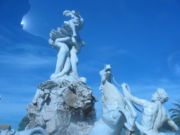
Perhaps one of the most enigmatic figures of Argentine culture is Oscar Agustín Alejandro Schulz Solari, aka Xul Solar, whose watercolor style and unorthodox painting media draws large crowds at museums worldwide; he also 'invented' two imaginary languages. The works of Candido Lopez (in Naïve art style), Emilio Pettoruti (cubist), Antonio Berni ( neo-figurative style), Fernando Fader, and Guillermo Kuitca are appreciated internationally.
Benito Quinquela Martín is considered to be the quintesennial 'port' painter, to which the city of Buenos Aires and particularly the working class and immigrant-bound La Boca neighbourhood, was excellently suited for. Lucio Fontana and Leon Ferrari are acclaimed sculptors and conceptual artists. Ciruelo is a world-wide famous fantasy artist and sculptor and Eduardo MacIntyre's geometric designs have influenced advertisers worldwide since the 1970s.
Food and drink
Argentine food is influenced by cuisine from Spain, Italy, Germany, France and other European countries, and many foods from those countries such as pasta, sausages, and desserts are common in the nation's diet. Argentina has a wide variety of staple foods, which include empanadas, a stuffed pastry; locro, a mixture of corn, beans, meat, bacon, onion, and gourd; and chorizo, a spicy sausage. Other popular items include facturas ( Viennese-style pastry), Dulce de Leche and mate, Argentina's national beverage.
The Argentine barbecue, asado as well as a parrillada, is one of the most famous in the world and includes various types of meats, among them chorizo, sweetbread, chitterlings, and morcilla ( blood sausage). Thin sandwiches, sandwiches de miga, are also popular. Argentines have the highest consumption of red meat in the world.
Since 1992, Argentina has invested over 650 million dollars to modernize the wine industry. The country is an important wine producer, rated fifth in the world, with the annual per capita consumption of wine amongst the highest in the world. ( Malbec has become a representative variety from Argentina). Malbec grape, a discardable varietal in France (country of origin), has found in Province of Mendoza an ideal environment to successfully develop and turn itself into the world's best Malbec. The city of Mendoza is one of the eight wine capitals of the world, and Mendoza accounts for 70% of the country total production (all varietals considered). "Wine tourism" is important in the Province of Mendoza, with the impressive landscape of Cordillera de Los Andes and the highest peak in America, Mount Aconcagua, 6952 meters high, providing a very desirable destination for international tourism.
Sports
Football (soccer) is the most popular sport in Argentina, whose national team is twice FIFA World Cup Champion and one-time Olympic Gold medalist (also fourteen-time Copa América winners).
Also widespread are volleyball and basketball; a number of basketball players participate in the NBA and European leagues. Manu Ginobili, Andres Nocioni, Carlos Delfino, and Fabricio Oberto are a few, and the national team won Olympic Gold in the Athens Olympics. Argentina has an important rugby union football team, "Los Pumas" (see Argentina national rugby union team), with many of its players playing in Europe. Argentina beat host nation France twice in the Rugby World Cup 2007, placing them third in the competition. The Pumas currently sit at fourth spot in the International Rugby Board's official world rankings. Argentine tennis is very competitive on the world stage, with dozens of players, male and female, in active tour.
Other popular sports include field hockey (the top female sport, see Las Leonas), golf, and sailing. Argentina has the highest number of highly-ranked polo players in the world and the national squad has been the uninterrupted world champion ever since 1949. The Open Polo Championship of Buenos Aires is the most important polo-related event in the world. Cricket is growing in popularity due to the National Team's recent successes where they came as the underdogs and finished runner's up of the Inaugural World Cricket League Division 3. Baseball is played in a most limited fashion, as well as the Gridiron.
Motorsports are well represented in Argentina, with Turismo Carretera and TC 2000 being the most popular car racing formats. People all over the country enjoy the races, but it is most fervently followed in small towns and rural Argentina, attracting a rather similar demographic as NASCAR in the United States. The Rally Argentina is part of the World Rally Championship (currently held in Córdoba Province). In Formula 1 racing, the country produced one world champion (Juan Manuel Fangio, five times) and two runners-up (Froilán González and Carlos Reutemann, once each)
The official national sport of the country is pato, played with a six-handle ball on horseback.
Music
Tango, the music and lyrics (often sung in a form of slang called lunfardo), is Argentina's musical symbol. The Milonga dance was a predecessor, slowly evolving into modern tango. By the 1930s, tango had changed from a dance-focused music to one of lyric and poetry, with singers like Carlos Gardel, Roberto Goyeneche, Hugo del Carril, Tita Merello, and Edmundo Rivero. The golden age of tango (1930 to mid-1950s) mirrored that of Jazz and Swing in the United States, featuring large orchestral groups too, like the bands of Osvaldo Pugliese, Anibal Troilo, Francisco Canaro, and Juan D'Arienzo. After 1955 tango turned more intellectual and listener-oriented, led by Astor Piazzolla. Today tango has worldwide popularity, and the rise of neo-tango is a global phenomenon with groups like Tanghetto, Bajofondo and Gotan Project.
Argentine rock, called rock nacional, is the most popular music among youth. Arguably the most listened form of Spanish-language rock, its influence and success internationally owes to a rich, uninterrupted development. Bands such as Soda Stereo or Sumo, and composers like Charly García, Luis Alberto Spinetta, and Fito Páez are referents of national culture. Mid 1960s Buenos Aires and Rosario were cradles of the music, and by 1970 Argentine rock was established among middle class youth (see Almendra, Sui Generis, Pappo, Crucis). Seru Giran bridged the gap into the 1980s, when Argentine bands became popular across Latin America and elsewhere ( Enanitos Verdes, Fabulosos Cadillacs, Virus, Andrés Calamaro). There are many sub-genres: underground, pop oriented, and some associated with the working class ( La Renga, Attaque 77, Divididos, Hermética, V8, Tren Loco, Los Redonditos). Current popular bands include: Babasonicos, Rata Blanca, El Otro Yo, Attaque 77, Bersuit, Los Piojos, Intoxicados, Catupecu Machu, and Miranda!.
European classical music is well represented in Argentina. Buenos Aires is home to the world-renowned Colón Theatre. Classical musicians, such as Martha Argerich, Daniel Barenboim, Eduardo Alonso-Crespo, Eduardo Delgado, Lalo Schiffrin, and classical composers such as Alberto Ginastera, are internationally acclaimed. All major cities in Argentina have impressive theaters or opera houses, and provincial or city orchestras. Some cities have annual events and important classical music festivals like Semana Musical Llao Llao in San Carlos de Bariloche and the multitudinous Amadeus in Buenos Aires.
Argentine folk music is uniquely vast. Beyond dozens of regional dances, a national folk style emerged in the 1930s. Perón's Argentina would give rise to Nueva Canción, as artists began expressing in their music objections to political themes. Atahualpa Yupanqui, the greatest Argentine folk musician, and Mercedes Sosa would be defining figures in shaping Nueva Canción, gaining worldwide popularity in the process. The style found a huge reception in Chile, where it took off in the 1970s and went on to influence the entirety of Latin American music. Today, Chango Spasiuk and Soledad Pastorutti have brought folk back to younger generations. Leon Gieco's folk-rock bridged the gap between argentine folklore and argentine rock, introducing both styles to millions overseas in successive tours.
Other notable musicians include Gato Barbieri with his seductive saxophone and free jazz compositions, and Jaime Torres and his spacious andean music.
Religion
Argentines are predominantly Roman Catholic. Around 93% declare themselves Roman Catholic according to different surveys; the Church estimates an affiliation of 70%. According to the Constitution, the Argentine government should support Roman Catholicism. However, this does not imply that it is the official religion of the Argentine Republic, nor does it imply that people working in the government should have this faith.
Evangelical churches have gained a foothold in Argentina since the 1980s, and their followers now number more than 3.5 million, about 10% of the total population. Traditional Protestant communities are present in most communities.
Members of The Church of Jesus Christ of Latter-day Saints (Mormons) numbering over 330,300, the seventh-largest concentration in the world, are also present.
The country also hosts the largest Jewish population in all of Latin America, about 2 percent of the population.
Islam in Argentina constitutes approximately 1.5% of the population, or an estimated 500,000-600,000 (93% Sunni). Argentina is also home to one of the largest mosques in Latin America, serving Argentina's Muslim community.
Approximately 12% of Argentines can be considered agnostic, and 4% are atheists.
Language
The official language of Argentina is Spanish, usually called "Castellano" ( Castilian) by Argentines.
A phonetic study conducted by the Laboratory for Sensory Investigations of CONICET and the University of Toronto showed that the accent of the inhabitants of Buenos Aires (known as porteños) is closer to the Neapolitan dialect of Italian than any other spoken language. Italian immigration and other European immigrations influenced Lunfardo, the slang spoken in the Río de la Plata region, permeating the vernacular vocabulary of other regions as well.
Argentines are the largest Spanish-speaking society that universally employs what is known as voseo (the use of the pronoun vos instead of tú (you), which occasions the use of alternate verb forms as well). The most prevalent dialect is Rioplatense, whose speakers are primarily located in the basin of the Río de la Plata.
Standard German is spoken by between 400,000 and 500,000 Argentines of German ancestry, though it has also been stated that the there could be as much as 1,800,000. German today, is the third or fourth most spoken language in Argentina.
According to one survey, there are around 1,500,000 Italian speakers (which makes it the second most spoken language in the country) and 1,000,000 speakers of Levantine Arabic, but these numbers are probably no longer current, as the newer generations mostly switch to Spanish and do not speak the ancestral language in the home. The same phenomenon applies to the Galician language that was used by many Spanish immigrants, Yiddish, and Japanese. The usage of these languages is in decline, as the respective immigration waves ended in the first half of the 20th century.
Some indigenous communities have retained their original languages. Guaraní is spoken by some in the northeast, especially in Corrientes (where it enjoys official status) and Misiones. Quechua is spoken by some in the northwest, and has a local variant in Santiago del Estero. Aymara is spoken by members of the Bolivian community who migrated to Argentina from Bolivia. In Patagonia there are several Welsh-speaking communities. More recent immigrants have brought Chinese and Korean, mostly to Buenos Aires. English, Brazilian Portuguese and French are also spoken. English is commonly taught at schools, with Portuguese and French behind.
Education
After independence, Argentina constructed a national public education system in comparison to other nations, placing the country high up in the global rankings of literacy. Today the country has a literacy rate of 97% (2003 Est.)
School attendance is compulsory between the ages of 5 and 17. The Argentine school system consists of a primary or lower school level lasting six or seven years, and a secondary or high school level lasting between five to six years. In the 1990s, the system was split into different types of high school instruction, called Educacion Secundaria and the Polimodal. Some provinces adopted the Polimodal while others did not. A project in the Executive to repeal this measure and return to a more traditional secondary level system was approved in 2006. President Domingo Faustino Sarmiento is overwhelmingly credited in pushing and implementing a free, modern education system in Argentina. The 1918 University reform shaped the current tripartite representation of most public universities.
Education is funded by tax payers at all levels except for the majority of graduate studies. There are many private school institutions in the primary, secondary and university levels. Around 11.1 million people were enrolled in formal education of some kind:
- 9,551,728 people attended either kindergarten, primary (lower school), or secondary (high school) establishments;
- 494,461 people attended non-university level establishments (such as training or technical schools);
- 1,125,257 people attended colleges or universities.
Education in public schools (primary, secondary and tertiary) is free. Public education, which was perceived to be of the best quality during the mid 20th century, is now often perceived to be bad and in continuous decline because of lack of funding. This has helped private education to flourish, albeit it has also caused an imbalance in terms of who can afford it (usually middle and upper classes), as often private schools have no scholarship systems in place.
There are thirty-eight public universities across the country, as well as several private. The Universities of Buenos Aires (the largest one, has 300,000 students), Córdoba (110,000 students and one of the oldest in the continent), Rosario (75,000 students), La Plata (75,000 students) and UTN (National Technological University, 70,000 students) are among the most important. Public universities faced cutbacks in spending during the 1980s and 1990s, which led to a decline in overall quality.
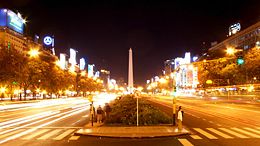
Holidays
Public holidays include most of the Catholic holidays, though holidays of other faiths are respected. The main historic holidays include the anniversaries of the May Revolution ( May 25), the Independence Day ( July 9), National Flag day ( June 20), and the death of the hero José de San Martín ( August 17).
On Christmas Eve, the extended family gathers around 9 p.m. for dinner, music, and often dancing. Candies are served just before midnight, when fireworks displays begin. The evening also includes opening gifts from Papá Noel (Father Christmas or "Santa Claus"). New Year's Day is marked with fireworks as well. Other holidays include Good Friday and Easter; Labor Day ( 1 May), and sovereignty Day (former Malvinas Day) ( 2 April).
Science and technology
Argentina has contributed many distinguished doctors, scientists, and inventors to the world, including three Nobel Prize laureates in sciences.
Argentines have been responsible for major breakthroughs in world medicine. Domingo Liotta designed and developed the first artificial heart successfully implanted in a human being in 1969. René Favaloro developed the techniques and performed the world's first ever coronary bypass surgery, and Francisco de Pedro invented a more reliable artificial cardiac pacemaker. Medicine's Nobel laureate Bernardo Houssay, the first Latin American awarded with a Nobel Prize, discovered the role of pituitary hormones in regulating glucose in animals; Medicine's Nobel laureate César Milstein did extensive research in antibodies; and Chemistry's Nobel laureate Luis Leloir discovered how organisms store energy converting glucose into glycogen, and the compounds which are fundamental in metabolizing carbohydrates. Dr. Luis Agote devised the first safe method of blood transfusion and Dr. Domingo Liotta the first purely artificial heart. Enrique Finochietto designed operating table tools such as the surgical scissors that bear his name ("Finochietto scissors"), and a rib-spreader. Roberto Zaldívar is a pioneer in laser-eye procedures and research. Argentine research has led to advancement in wound-healing therapies, heart disease, and in several forms of cancer.
Argentina's nuclear program is highly advanced. Argentina developed its nuclear program without being overly dependent on foreign technology. Nuclear facilities with Argentine technology have been built in Peru, Algeria, Australia, and Egypt. In 1983, the country admitted having the capability of producing weapon-grade uranium, a major step to assemble nuclear weapons. Since then Argentina has pledged to use nuclear power only for peaceful purposes.
In other areas, Juan Vucetich, a Croatian immigrant, was the father of modern fingerprinting (dactiloscopy). (see fingerprint), Raúl Pateras de Pescara demonstrated the world's first flight of a helicopter, Hungarian-Argentine László Bíró mass-produced the first modern ball point pens and Eduardo Taurozzi developed the more efficient pendular combustion engine. Juan Maldacena, an Argentine-American scientist, is a leading figure in string theory. An Argentine satellite, the PEHUENSAT-1 was successfully launched on January 10, 2007 using the Polar Satellite Launch Vehicle ( PSLV).
International rankings
| Organization | Survey | Ranking |
|---|---|---|
| Heritage Foundation/The Wall Street Journal | Index of Economic Freedom | 107 out of 157 |
| The Economist | Worldwide Quality-of-life Index, 2005 | 40 out of 111 |
| Reporters Without Borders | Worldwide Press Freedom Index | 76 out of 167 |
| Transparency International | Corruption Perceptions Index | 105 out of 163 |
| United Nations Development Programme | Human Development Index | 38 out of 177 |



